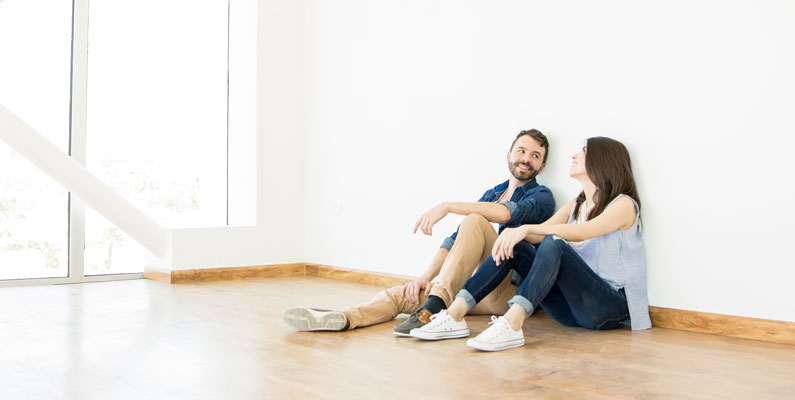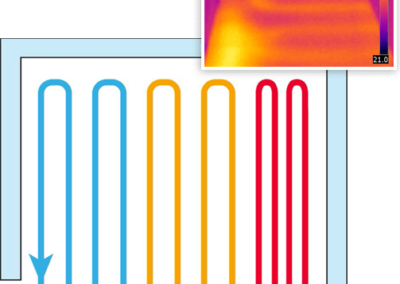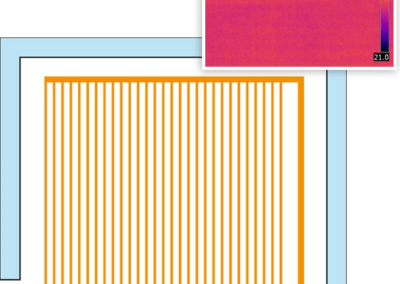Imagine coming home in the summer after a long day at the office. Temperatures outside reach 35 degrees and more. In the office, the air conditioner was constantly running and whirring in your ear. The air was dry, because of the draft you have a neckache and headache. Also, your colleagues were arguing about what temperature to set the air conditioner at.
You enter your apartment and there is a pleasant indoor climate – cool, but not dry. It’s like you’re resting in the shade of a tree. Your wall cooling is responsible for this. It belongs to the surface cooling systems and in this case tempers the room through the wall surface.
Still not convinced how to do it and why you should go for wall cooling? In this post, I’ll explain how wall cooling works, what advantages it has for you, and what you should consider before buying.
I have gathered the knowledge for this over the last 20 years: Installations of surface cooling systems – including some wall cooling systems – for more than 3500 private homes and company buildings . In the process, I have learned one thing: With these cooling systems, you create an indoor climate that everyone finds pleasant.
Mode of operation: Wall cooling vs. classic air conditioner
Wall cooling is based on the same system as wall heating, except that cool water is pumped through the pipes. What does that mean? To understand how wall cooling works, I’ll first explain the 3 ways heat can be transferred. We can then apply this to the wall cooling.
- Heat flow or convection: Heat is transferred by air currents. If you use a hairdryer, for example, the heated air is directed onto your hair by means of a fan.
- Heat conduction: If you put a pot on the stove top, the heat is transferred from the hot plate to the cold pot.
- Heat radiation: You cannot see the infrared radiation, but you can feel it all the more strongly. It consists of electromagnetic waves that transfer heat. Note: Objects and bodies also radiate heat. However, how much depends on their heat. For example, if the sun shines directly on you in winter, you can even sit outside in a T-shirt without freezing because of its heat radiation.
We can also use these types of heat transfer for cooling systems. Why? Because the heat always goes to the cold spots. The wall cooling system takes advantage of this.
In a wall cooling system, chilled water circulates through a pipe system that is installed in a serpentine, spiral, or parallel configuration. The wall is cooled down.
People give off heat all the time. If there are no cooler surfaces in the room, the person cannot give off his heat and becomes hot.
If cooled surfaces are present, as in this case due to wall cooling, we can transfer our body heat to these cool areas. There is a natural exchange of radiation, which provides a pleasant cooling effect.
In our video, we explain once again in detail how a surface cooling system works:
This is quite different with conventional cooling variants such as air conditioners: these are based on the principle of convection. They provide what is known as “climate shock.” The air in the room is regulated down to a certain temperature.
The spot-cooled air sinks to the floor while the warm air rises. This air circulation raises dust and exposes you to drafts. Many people complain of headaches, colds or breathing problems caused by air conditioning.
What temperature should you set the wall cooling to?
To be able to cool effectively, the temperature of the cooled area should be around 16 °C – 20 °C. Since you perceive heat differently on different parts of your body, the exact temperature setting depends on your temperature sensation.
But you know what the best thing about wall cooling is? If you use the “natural” cold for cooling the water, you can reduce your energy costs to a minimum or even to 0.
“Natural” cold saves energy costs
The natural cold from basements or the ground will help you save on your wall cooling energy costs. There can be temperatures of about 15 degrees Celsius in the summer. So how can you use this cold for your wall cooling?
To do this, you first install a pipe system for wall cooling in your living spaces. Then you connect this system with an additional pipe system laid in the ground under your house or in the basement. This should be able to store the same amount of water as the system in the house.
The basement is nice and cool in the summer, so the water in the pipes can be cooled practically “naturally” by the cooler temperature and the cold walls. If the living rooms are now warm, you can pump the cold water from the basement into the apartment. As a result, the warm water from the pipe system of the living rooms is directed to the basement.
There, the warm water is cooled down again. As soon as the apartment gets too warm again, you can pump the cooled water back up. This process goes on and on like this. This way you can cool your house or apartment without using much energy.
Of course, you can also install an electric heat pump as an energy source for cooling the water. This generates cold by means of electricity, like a refrigerator. The advantage is that you can use this type of heat pump for cooling in the summer and for heating in the winter.
The 4 biggest advantages of wall cooling
Advantage #1: Healthy cooling
With a wall-mounted cooling system, you are relying on “healthy and natural” cooling. No dust turbulence or drafts are generated during the radiation exchange. In addition, the air also does not dry out. Therefore, this method of cooling is particularly suitable for asthmatics and allergy sufferers.
Advantage #2: Noiseless cooling
In addition, the wall cooling is completely silent, so you don’t have the whirring of the air conditioner in your ears all the time. So nothing stands in the way of installation in the bedroom.
Advantage #3: Ventilation allowed
If you use air conditioning, you should refrain from ventilating. With wall cooling, you can open your windows to let in fresh air despite the summer heat.
Advantage #4: Save energy costs
For cooling the wall electric heat pump requires little energy. If you use natural cooling from the ground, even this energy expenditure is reduced to a minimum. This way, you can reduce your energy costs sustainably and even protect the environment.
Want to learn even more about the benefits? Then you can watch our YouTube video about it:
Can I install wall cooling at my place? Can I do this myself?
Wondering if your apartment, house or office is even suitable for wall cooling? And whether you can do the installation yourself? Right away: Yes, do-it-yourself installation is possible. However, you should think about a few things in advance to save on material costs and find the ideal solution for you.
- In which rooms should the wall cooling be used?
- For what size of area do you need the wall cooling? (square meters)
- Do you live in an old or new building?
- Do you want to use the system for heating as well?
- Are your walls sufficiently insulated for this?
- Are you assembling the pipes in a dry or wet system?
- Do you take care of the assembly or do you leave it to a professional?
- Should the wall cooling pipes be installed serially (serpentine or spiral) or parallel (Tichelmann system)?
I recommend that you consult a professional to answer these questions. This way you can be sure that you are getting a system that really fits your needs. Because: A wrong decision can have fatal consequences.
You don’t want to take the risk of a wrong purchase, but rely on a proven wall cooling? A wall cooling ideal for self-installation, suitable for any type of building ? Then you should definitely read on. I will now introduce you to the “egger system”.
Simple and compatible: egger wall cooling for every building
With the egger system, you can also cool any type of building – whether old or new, apartment, office, workshop or production hall.
In the egger system, the pipes for wall cooling are laid parallel and not serpentine. This means that the surfaces are cooled evenly. Why? The water does not have to “snake” through the entire pipe system first. It has a shorter travel distance, does not heat up as much and consequently does not need to be cooled as much. We explained in more detail how this works in our blog post “Cooling with Tichelmann or snake system“.
If you want to heat as well as cool, that’s no problem with our system. So you have a pleasant feel-good climate all year round in your four walls or in the office.
Conclusion: With the parallel-running egger system, your walls will be cooled faster, more evenly and more cost-effectively than with conventional wall cooling systems.
Still not enough of egger feel-good climate? Contact us!
Could I make you curious? Do you have any questions about our wall cooling systems or the egger system? We will be happy to advise you during a free initial consultation. You can contact us by phone(+43 5223 411 68 11), by e-mail or via our contact form.
By the way, you can find our wall cooling system or wall heating in our egger Wohlfühl-Klima Shop. So that you can install it on your own at home, we of course include step-by-step instructions.
Love greetings
Annette & Christian Egger





